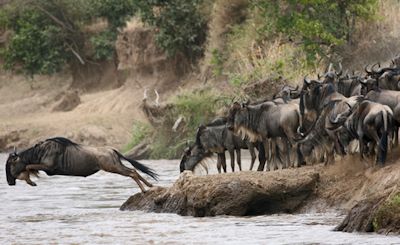 The Masai Mara national wildlife reserve is found in Southwestern Kenya, about 290km from Nairobi. The area has a very high number of different wild animals and it is not only the best places to enjoy a Safari in Kenya but also one of Africa’s leading tourist destinations.
The Masai Mara national wildlife reserve is found in Southwestern Kenya, about 290km from Nairobi. The area has a very high number of different wild animals and it is not only the best places to enjoy a Safari in Kenya but also one of Africa’s leading tourist destinations.
Considered as another wonder in the world, the Wildebeest migration which takes place in this reserve is among the top reasons why millions and millions of tourists travel from all parts of the world simply to see this amazing wonder.
Back in the 1960’s and 1970’s when the Migration was the biggest tourism boom on the African continent, the number of animals assumed to take part in this migration was estimated to be 250,000, however, this number has gradually increased and of today, there are over 1.5 million wildebeests, 12,000 elands, 400,000 Thomson’s gazelles and about 300,000 zebras. These great numbers have made this ‘wildlife match’ one of the most beautiful wildlife scenes on the planet.
This large herd is followed by hundreds of big cats as it offers plenty of prey for them. The giant crocodiles in River Mara also lie eagerly waiting, for this large herd to cross the river.
This amazing wildlife phenomenon on the other hand did not really please the local Masai people living around the reserve because the migrating herd competes for pasture with the cattle herds belonging to the people. In addition the wild animals also poison the drinking water holes of the cattle with feces as well as transmit diseases to them.
This internationally renowned wildlife famous migration runs in a circle which implies that there is no beginning or ending point. The animals keep moving in search of green pastures so they keep on moving from one place to another.
The Serengeti plains are also much loved by the herd due to the availability of grass there. Its in this area that actually the wildebeests give birth to calves wit totals reaching almost 500,000 calves. However, most of these calves are hunted and killed by the different predators such as Jackals and Hyenas.
The surviving new born calves will have a very minimal time to strengthen their legs because once the calving session is over, the “pilgrim” continues.
In the month of April, the rains in the southern parts of Serengeti are finished so the plains are then dry. The great wildlife herd then converges together and march towards the northern and western direction abandoning the exhausted grasslands in southern Serengeti for the tall grass in the Western corridor, close to Lake Victoria’s shores.
The matching herd is normally led by the zebras which prefer the long stems of the rough grass. These then leave behind the shorter grass that is preferred by the wildebeests.
Crossing into the Masai Mara Reserve
From late June into July the animals cross into the Masai Mara reserve found in Kenya where the grass is tender, fresh and rich with minerals.
The animals spend most of the time in the northeastern side of the Mara Reserve in the Loita plains. Once the area becomes dry and exhausted and dry, the animals move into the central part of the reserve which has greener pastures.
Crossing River Mara
The migrating animals spend 3-4 months inside the Masai Mara Reserve, they cross the Sand River a tributary of the long River Mara found on the border of Kenya and Tanzania. Around this time when they cross the river, the Mau Escarpment is receiving heavy rains which in turn flood River Mara.
The giant crocodiles lay waiting eagerly on the large prey that is coming around.
Finally, the animals reach the banks of the river where they wander for sometime looking for a convenient point to cross. They search for a less steep area with less danger and eventually one courageous animal’s steps into the river and it is followed by the rest moving in an organized line as they cross the river.
Unfortunately, during the river crossing some animals are attacked by the hungry crocodiles while some others drown, however, this does not stop the herd from continuing with their journey as they head to for the green pastures.
Back to Serengeti
Then in October, they head back to the Serengeti southern grasslands which are verdant and filled with fresh pastures. This cycle continues year after year. It is an amazing phenomenon to watch and on this safari, don’t forget to carry your Camera.


UGANDA SAFARI PACKAGES :